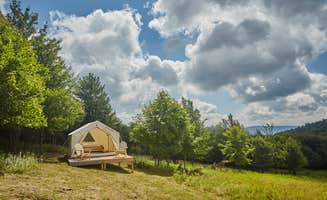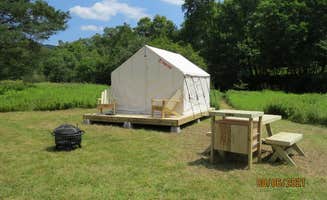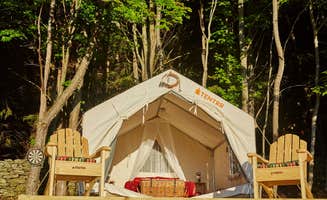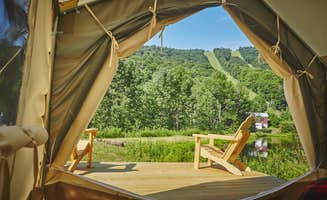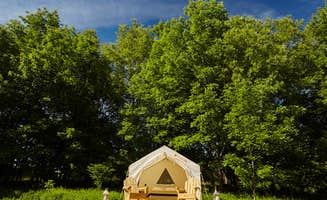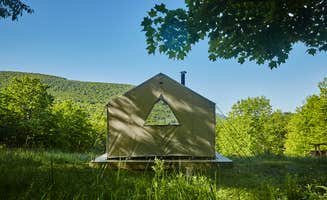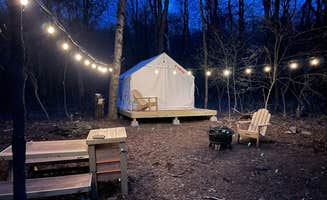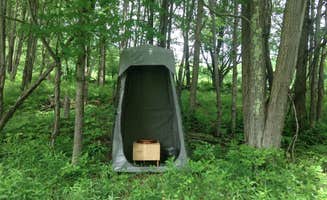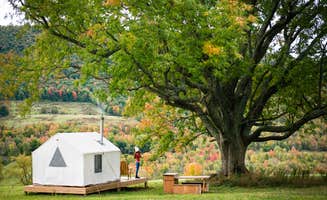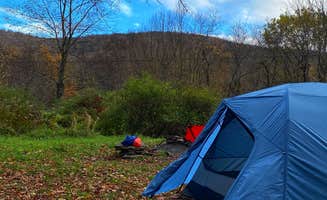Camping spots near New Kingston, New York range from primitive backcountry sites to family-friendly established campgrounds across elevations from 1,200 to 3,500 feet. The Catskill region has significant temperature variations between valley and mountain sites, with mountaintop locations typically 10-15°F cooler than valley campgrounds. Most primitive camping areas don't provide trash collection, requiring campers to pack out all waste.
What to do
Hiking to mountain fire towers: Several campgrounds provide access to historic fire tower hikes. At Bear Spring Mountain — DEC, visitors can combine camping with hiking. "There is a hiking loop that goes around the pond. Highly recommended if you like hiking. Great flowers and nature," notes J G. Some trails connect to more challenging routes.
Kayaking on wilderness lakes: Multiple camping locations offer paddling opportunities on small mountain lakes. "Got a kayak for the day and it was a great rate. Saw beavers and eagles," writes Lauren S. about her experience at Little Pond Campground. The rental options save visitors from transporting their own equipment.
Fishing in mountain streams: The region's cold-water streams support trout fishing. "Nice quiet campgrounds close to the Beaver kill and great service staff was supper friendly and helpful," mentions Kipa S. about Little Pond's proximity to fishing areas. Several campgrounds are situated directly on streams with fishing access from campsites.
Creek exploration: Many campsites back directly onto mountain streams. "The mountain creek is like nature singing a lullaby - sleeping next to it was very relaxing," shares John N. about Woodland Valley Campground. Several sites feature shallow areas where children can safely wade during summer months.
What campers like
Private walk-in sites: Several campgrounds offer more secluded options for those willing to carry gear. "We had a walk in site and it was fantastic! Right on the water and pretty private. Each walk in site has its own bear box and outhouse," reports Lauren S. about Little Pond. Some walk-in sites require only short distances from parking areas.
Waterfront camping: Sites adjacent to lakes and streams are consistently popular. At Alder Lake, "There are several beautiful, secluded hike-in sites along the lake which I would love to return to someday. The hike around the lake is a lovely, easy walk," explains Erik C. Many waterfront sites provide direct water access from campsites.
Clean facilities: Even at more rustic campgrounds, bathroom maintenance receives attention. At Catskill/Kenneth L Wilson Campground, "The bathrooms were very clean and new and the showers were free and temperature controlled to perfectly warm!!" reports Melanie H. Most established campgrounds provide shower facilities, though primitive sites typically only offer pit toilets.
Star-gazing opportunities: The mountain location creates excellent night sky viewing. "Weather was great and we could see the stars through the canopy - very very enjoyable!" notes John N. about Woodland Valley. Limited light pollution in the area enhances astronomical observation compared to more developed regions.
What you should know
Bear activity requirements: All camping areas in the region have bear populations requiring proper food storage. "There are bears and if you leave food out you will get a warning notice if seen," reports Phillip L. about Kenneth L Wilson campground. Many established campgrounds provide metal food lockers, while backcountry sites require bear canisters or proper hanging techniques.
Limited or no cell service: Most campgrounds have minimal connectivity. At Little Pond, "Cell service is non existent and they have a pay phone near the entrance booth where you can use to make/receive phone calls. It's a 20 min drive back into town to get cell service," explains Giselle P. Several campers note complete disconnection from service as a consideration for planning.
Variable campsite sizes: Sites vary significantly in size and privacy. At Beaverkill Campground, "My only complaint would be the size of each campsite. Some are larger than others but overall most sites are fairly small and there isn't much privacy between them," notes Luke S. Research specific site dimensions when making reservations.
Weather variability: Higher elevation sites can experience rapidly changing conditions. "We got rained out. But it was still an awesome campground," reports Erica H. about Woodland Valley. Temperature drops can be significant after sunset, even in summer months, requiring appropriate clothing and sleeping gear.
Tips for camping with families
Pool access: Some campgrounds offer swimming facilities beyond natural water features. At Crazy Acres Campground at Beaver Spring Lake, families appreciate "plenty of activities, a big lake to fish in and a pool to relax by. Nighttime family fun as well," according to Robert M. Swimming areas typically open Memorial Day through Labor Day, weather permitting.
Playground availability: Several campgrounds maintain play areas for children. At Bear Spring Mountain, "Small playground was nice for the kids," notes Becky S. These facilities provide recreation options during downtime between hiking or water activities.
Short nature trails: Many campgrounds include easy walking paths suitable for young hikers. "The hike around the lake is a lovely, easy walk," explains Erik C. about Alder Lake. These trails typically range from 0.5 to 2 miles and offer wildlife viewing opportunities without significant elevation changes.
Site selection for privacy: Families should research specific sites that offer more seclusion. "Site 58 on Loop C... allowed you to be pretty far back from the road for more privacy, but some of the other sites were literally next to the road," advises Katherine P. about Kenneth L Wilson campground. Corner sites and those at the end of loops typically offer more buffer from other campers.
Tips for RVers
Access road conditions: Some campgrounds have challenging approach roads. At Giant Ledge Primitive Camp, "Was not the easiest for my RV van to get up the hill with the ruts, but I have a small lift so it helps, lower clearance vans might not make it," warns SJ W. Many forest roads remain unpaved with seasonal rutting.
Site leveling requirements: The mountainous terrain creates uneven sites requiring leveling equipment. "The sites were well taken of by other campers and almost look brand new," notes Phillip L. about Kenneth L Wilson, though many sites still require substantial leveling blocks.
Limited hookup availability: Most public campgrounds offer minimal or no hookups. At Woodland Valley, generator use is prohibited, creating challenges for power-dependent RVers. Several private campgrounds provide more extensive hookups but with less natural surroundings.
Dump station access: Not all campgrounds with RV sites provide on-site dump stations. For campgrounds without facilities, the nearest dump stations may be 15-20 miles away at larger campgrounds or highway rest areas. Most established campgrounds update their dump station status on reservation websites.


